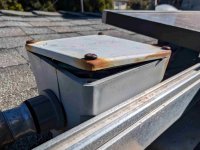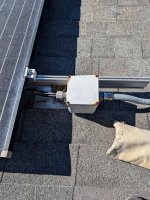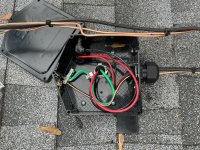Well maybe the OP can show us what he is using.I wonder what that listing would mean. Would it mean that the box is water tight or just that it won't deteriorate if it gets wet?
You are using an out of date browser. It may not display this or other websites correctly.
You should upgrade or use an alternative browser.
You should upgrade or use an alternative browser.
When to require bonding both ends of a home-run conduit to the EGC?
- Thread starter photonboy
- Start date
- Status
- Not open for further replies.
Frankly, I did not know about that requirement.In nonresidential, would a metal bell box be listed for bonding over 250V (250.97)?
Or is this just for the DC circuit wiring on the roof / only works in residential because they don't make them large enough for commercial?
Over 100 or so inspections of both >250V DC installs and <250V Enphase installs I have never had an inspector complain about our bell box as J box. Take that for what it is worth.
I've been simply running on the requirement to use bonding bushings if over 250V AND also concentric/eccentric knockout in the box, or non conductive box.
A bell box is a solid, one piece molded box. Aluminum I believe. With threaded outlets/hubs.
Seems solid to me.
Though.... that is no Code reference!
Bonding bushings are the tiniest - YET most laborious - product to install PROPERLY. I avoid them like the plague. So i use metal boxes and cut my own hole or smallest KO that just fits with no welded rings remaining.
jaggedben
Senior Member
- Location
- Northern California
- Occupation
- Solar and Energy Storage Installer
You are right of course, but it's ridiculous, and I'm willing to go on record here to say that I literally don't care.Any box used in a wet location needs to be listed per 314.15, so that's a given. The question is what the 2020 NEC 250.92(B)(2) language "Connections using threaded couplings or listed threaded hubs on enclosures if made up wrench tight" means. Do you have to use a listed hub? It's silent on integral threaded entries.
The 2023 NEC 250.92(B)(2) language is clearer: "Connections made up wrenchtight using threaded couplings, threaded entries, or listed threaded hubs on enclosures." So any integral threaded entry suffices, and the part about "listed threaded hubs" only applies to add on hubs.
Cheers, Wayne
If the plastic boxes are suited for wet installations I think they probably have some hub type entry and that would make attaching a grounding bushing impossible. If they are using a residential type plastic box I would think the whole installation is questionable, hence my post # 19
photonboy
Member
- Location
- Berkeley, CA, USA
- Occupation
- Ex roof monkey, current desk jockey
They don't have any pre-stamped knockouts, each one is drilled on site. Here are a couple of examples, one of which I think is pretty cool:My question to the OP is, if the plastic box is listed for wet locations what type of KO'S or hubs does it have?
Attachments
photonboy
Member
- Location
- Berkeley, CA, USA
- Occupation
- Ex roof monkey, current desk jockey
When bell boxes are used as roof j-boxes we do require the enclosure itself to be bonded with a lug or terminal, that bonding transfers to the metal conduit since there is sufficient thread engagement.FFS if the bell box says it's UL listed that's good enough for me.
jaggedben
Senior Member
- Location
- Northern California
- Occupation
- Solar and Energy Storage Installer
Right. I don't need some further proof that the threaded hubs are listed for grounding.When bell boxes are used as roof j-boxes we do require the enclosure itself to be bonded with a lug or terminal, that bonding transfers to the metal conduit since there is sufficient thread engagement.
Because PV is a source.Why does pv grounding matter anymore than grounding anything else?
ggunn
PE (Electrical), NABCEP certified
- Location
- Austin, TX, USA
- Occupation
- Consulting Electrical Engineer - Photovoltaic Systems
Why does that make a difference? Unless a PV system is supply side interconnected, doesn't the grounding look the same as for any other feeder?Because PV is a source.
electrofelon
Senior Member
- Location
- Cherry Valley NY, Seattle, WA
- Occupation
- Electrician
I would say grounding for PV is less important if anything. All bonding will do is make it more likely the inverter will shut off hopefully alerting someone of a problem. Say you have a roof system that is isolated and has a fault. Isn't it just now a grounded system? Probably won't have any way to touch ground on a roof so even if it floats at non ground potential, a shock seems unlikely.
petersonra
Senior Member
- Location
- Northern illinois
- Occupation
- Semi-retired engineer
why would it matter for any source?Because PV is a source.
photonboy
Member
- Location
- Berkeley, CA, USA
- Occupation
- Ex roof monkey, current desk jockey
They are installed to be weatherproof, the snow pic was someone forgetting to close the box during install. Once buttoned up and covered with a module the boxes are weather tight, if installed correctly.So what is the point of using a plastic box if they are not installed to be weatherproof?
I'm not talking about the snow picture. The fittings used for the single conductors are not weatherproof unless they are filled with some type of compound.They are installed to be weatherproof, the snow pic was someone forgetting to close the box during install. Once buttoned up and covered with a module the boxes are weather tight, if installed correctly.
electrofelon
Senior Member
- Location
- Cherry Valley NY, Seattle, WA
- Occupation
- Electrician
As a little side rant, yeah I hate BB and doubt they even accomplish much. They are so horribly designed. They need more lug and setscrew options around the perimeter. Also most fittings are not deep enough for the setscrew to grab, especially when you use a plastic enclosure . Finally there is no anti turn function on the lug so pretty hard to get them to stay tight in practice.Bonding bushings are the tiniest - YET most laborious - product to install PROPERLY. I avoid them like the plague.
photonboy
Member
- Location
- Berkeley, CA, USA
- Occupation
- Ex roof monkey, current desk jockey
Fair point, although the strain relief fittings do have a foam/rubber gasket that snugs around the conductors when tightened and the boxes are typically under a module, best practice is to put the fittings on the downward side of the box but even when they side enter it's good enough, they aren't meant to be submerged, if they are then there are bigger problems..I'm not talking about the snow picture. The fittings used for the single conductors are not weatherproof unless they are filled with some type of compound.
shortcircuit2
Senior Member
- Location
- South of Bawstin
In general, nonmetallic boxes can only be used with nonmetallic cables and raceways.The NEC only requires that one end be bonded, wire EGC or not. Anything more is design choice.
If nonmetallic boxes are used with metallic raceway bonding at each end would be required per 314.3 Exception 1 & 2
So if EMT is used from the nonmetallic enclosure of the inverter to the nonmetallic deck-box, bonding (bushings) at both ends is required.
LarryFine
Master Electrician Electric Contractor Richmond VA
- Location
- Henrico County, VA
- Occupation
- Electrical Contractor
Even if the far box has nothing requiring grounding? What would you connect the bonding wire to?If nonmetallic boxes are used with metallic raceway bonding at each end would be required per 314.3 Exception 1 & 2
I don't quite see the connection (no pun intended) you do in 314.
Exception 1 mentions integral means, and exception 2 mentions threaded entries.
Does the presence or absence of an EGC in the EMT affect your comments?So if EMT is used from the nonmetallic enclosure of the inverter to the nonmetallic deck-box, bonding (bushings) at both ends is required.
If an EGC is present, I would think bonding one end would suffice.
If an EGC is not present, the EMT is the EGC, then I agree on needing the bushings.
Well those plastic boxes are better than the boxes I expected when you said plastic. I agree: definitely place any plastic UNDER the panels.They don't have any pre-stamped knockouts, each one is drilled on site. Here are a couple of examples, one of which I think is pretty cool:
Last plastic box I saw was this on a 10-year old install:
(I am skeptical metal boxes will look like this in 10 years)


Last edited:
The PVC box reminds me! Pls tell your subs that there are long threaded EMT raintight connectors. That makes a bonding bushing possible. A PVC box has THICK walls and it eats up all your thread on the EMT connector. Not enough thread left for the bushing.
You cannot get a bonding bushing on there and set the setscrew into metal thread to save your life half the time. Even if you were willing.
Sometimes just skipping the locknut (which no longer serves a purpose if adding a bondng bushing) gets you enough thread.
To be fair your 3 pics show thinner walled "plastic" boxes. Whereas mine, Cantex, I think is actually PVC and thicker.
You cannot get a bonding bushing on there and set the setscrew into metal thread to save your life half the time. Even if you were willing.
Sometimes just skipping the locknut (which no longer serves a purpose if adding a bondng bushing) gets you enough thread.
To be fair your 3 pics show thinner walled "plastic" boxes. Whereas mine, Cantex, I think is actually PVC and thicker.
Last edited:
- Status
- Not open for further replies.




